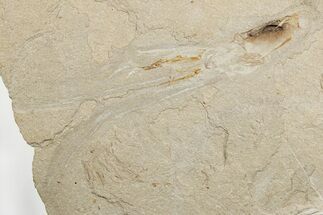This Specimen has been sold.
7.3" Fossil Cephalopod (Baculites) Cluster - South Dakota
This is a 7.3" wide cluster of Baculites fossils, collected from the Pierre Shale of South Dakota. There is a repaired crack through the shortest cephalopod, and the longest cephalopod appears to be a composite, hence the reduced price.
Comes with an acrylic display stand to assist with presentation.
Comes with an acrylic display stand to assist with presentation.
Baculites ("walking stick rock") is an extinct cephalopod genus with a nearly straight shell, included in the heteromorph ammonites. The genus lived worldwide throughout most of the Late Cretaceous.
As with other ammonites, the shell consisted of a series of camerae, or chambers, connected to the animal by a narrow tube called a siphuncle by which gas content and thereby buoyancy could be regulated, the same way as Nautilus does today.
From shell isotope studies, it is thought that Baculites inhabited the middle part of the water column, not too close to either the bottom or surface of the ocean.
Baculites fossils are very brittle and almost always break. They are most commonly found broken in half or several pieces, usually along suture lines. Individual chambers found this way are sometimes referred to as "stone buffaloes" (due to their shapes), though the Indigenous attribution typically given as part of the story behind the name is likely apocryphal.
As with other ammonites, the shell consisted of a series of camerae, or chambers, connected to the animal by a narrow tube called a siphuncle by which gas content and thereby buoyancy could be regulated, the same way as Nautilus does today.
From shell isotope studies, it is thought that Baculites inhabited the middle part of the water column, not too close to either the bottom or surface of the ocean.
Baculites fossils are very brittle and almost always break. They are most commonly found broken in half or several pieces, usually along suture lines. Individual chambers found this way are sometimes referred to as "stone buffaloes" (due to their shapes), though the Indigenous attribution typically given as part of the story behind the name is likely apocryphal.
SPECIES
Baculites sp.
LOCATION
Wasta, South Dakota
FORMATION
Pierre Shale
SIZE
Entire Specimen: 7.3" wide, Largest Cephalopod: 6.6" long
CATEGORY
SUB CATEGORY
ITEM
#262757
We guarantee the authenticity of all of our specimens.
 Reviews
Reviews












